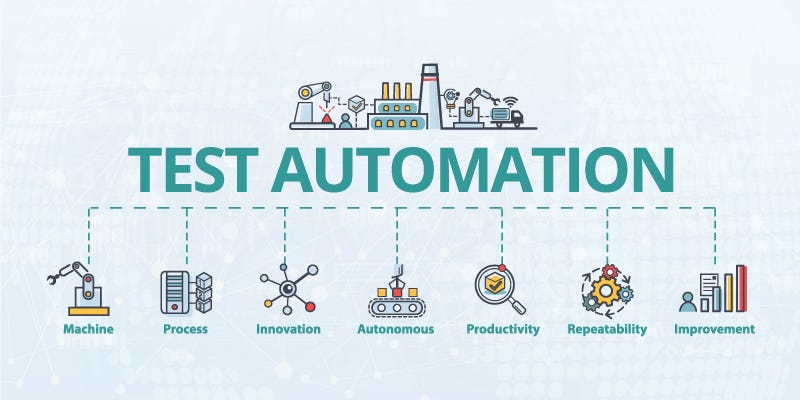Understanding Automation Testing: Devices, Techniques, and Benefits
Understanding Automation Testing: Devices, Techniques, and Benefits
Blog Article
From Guidebook to Automated Screening: A Comprehensive Overview to Transitioning Efficiently and Successfully
In the world of software testing, the change from manual to automated procedures has actually come to be an increasingly vital transition for organizations seeking to enhance efficiency and accuracy in their testing methods. As innovation continues to advancement, the requirement for effective and seamless computerized screening methods has never ever been extra important. The journey from manual to automated testing is not without its challenges, yet when approached strategically and with a clear plan in mind, the advantages can be significant - automation testing. In this extensive overview, we will certainly explore vital steps and considerations crucial for an effective shift, from the preliminary selection of devices to the integration of automation into existing workflows. Remain tuned to discover the understandings that will assist pave the method for a smoother and much more effective screening process.
Benefits of Automated Evaluating
Automated testing offers many advantages, enhancing effectiveness and accuracy in software application advancement processes. One main benefit is the substantial reduction in screening time. Automated tests can be run concurrently on several gadgets and operating systems, substantially quickening the testing phase contrasted to hand-operated screening. This enhanced efficiency enables faster comments on the quality of the software, making it possible for developers to recognize and resolve issues immediately.
Moreover, automated testing guarantees a higher level of accuracy in discovering flaws. Uniformity in screening is additionally enhanced, as automated tests perform the exact same steps precisely each time they are run.
Selecting the Right Devices

First of all, evaluate your objectives and requirements. Understand the scope of your project, the technologies involved, and the capability of your group. This evaluation will certainly help you identify the functions and abilities you require in your testing tools.
Second of all, consider the compatibility of the tools with your existing systems and procedures. Smooth integration with your current software program growth lifecycle is important to ensure a smooth transition to automation.
Furthermore, review the scalability and flexibility of the tools. As your testing needs develop, the devices need to be able to adapt and fit modifications properly.
Finally, consider the support and area around the tools. Durable assistance and an active customer neighborhood can offer beneficial resources and assistance when applying automated testing. By carefully taking into consideration these aspects, you can choose the right devices that line up with your needs and set the stage for an effective transition to automated screening.
Writing Efficient Examination Manuscripts

When crafting test scripts, it is vital to think about the particular demands of the software application being evaluated and make sure that the manuscripts address all crucial performances. Detailed and clear calling conventions for test scripts and test cases can enhance readability and maintainability. Additionally, including error handling devices within the test manuscripts can aid in identifying and addressing concerns immediately.
Moreover, organizing examination scripts right into modular elements can improve reusability and scalability, lowering redundancy and boosting performance in test script upkeep. Regular reviews and updates to check manuscripts are important to equal developing software demands and functionalities. By adhering to these principles, testers can produce reliable and durable examination manuscripts that add considerably to the success of automated screening procedures.
Integrating Automation Into Workflows
Effective integration of automation tools into existing process enhances and simplifies processes performance within software program development cycles. When incorporating automation into workflows, it is vital to recognize recurring jobs that can be automated to conserve time and minimize human mistake. By effortlessly incorporating automated screening tools like Selenium or Appium into the software application advancement lifecycle, groups can achieve faster feedback on code adjustments, causing quicker bug detection and resolution. This integration permits constant testing throughout the advancement process, making certain that any type of issues are recognized beforehand, causing greater software program high quality. In addition, automation can be made use of to set off tests instantly after each code commit, providing instant recognition and liberating testers check out here to concentrate on more complex situations. Proper combination of automation devices calls for cooperation in between advancement, testing, and operations groups to establish a unified process that maximizes efficiency and effectiveness in supplying high-quality software application items.
Ensuring a Smooth Change
Effectively transitioning to automated screening involves thorough preparation and careful implementation to decrease interruptions and maximize efficiency in the software program advancement procedure - automation testing. To make sure a smooth shift, it is necessary to begin by carrying out a detailed analysis of Read Full Report the existing testing procedures and recognizing locations where automation can bring one of the most substantial advantages. Engaging with all stakeholders early on in the process, consisting of developers, testers, and job managers, is crucial for garnering assistance and buy-in for the automation initiative
Communication is key during this change stage. Clear communication of the objectives, benefits, and assumptions of automated screening assists to manage any type of resistance or concerns that might occur. Additionally, giving sufficient training and sources for staff member to upskill in automation devices and techniques is crucial for making sure a successful shift.

Final Thought
Finally, transitioning from guidebook to automated testing offers numerous advantages, including boosted effectiveness and reliability. By selecting the proper devices, writing efficient test scripts, and incorporating automation effortlessly into process, companies can ensure a successful and smooth transition. It is important to welcome automation as a useful possession in software program screening procedures to enhance general quality and productivity.
In the realm of software screening, the change from guidebook to automated procedures has actually come to be a significantly vital transition for organizations seeking to improve performance and accuracy in their testing practices. Automated examinations can be run at the same time on multiple devices and operating systems, substantially speeding up the screening stage contrasted to hands-on testing. Consistency in screening is also boosted, as published here automated examinations implement the exact same steps exactly each time they are run.To guarantee the successful application of selected testing tools, the development of efficient test scripts plays an important duty in confirming the functionality and efficiency of automated processes - automation testing. By following these principles, testers can develop effective and robust examination scripts that add significantly to the success of automated screening procedures
Report this page